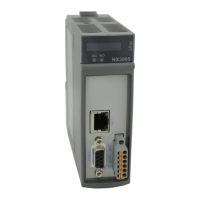5. CONFIGURATION
For cycle times equal or greater than 20 ms, the increase of the answer rate is linear, and may be calculated using an
equation:
N = C x (1 / T )
Where:
N is the medium number of answers per second; C is the number of active connections; T is the MODBUS task interval in
seconds.
As an example a MODBUS Server, with only one active connection and a cycle time of 50 ms we get:
C = 1; T = 0,05 s;
N = 1 x (1 / (0,05))
N = 20
That is, in this configuration the MODBUS Server answers, on average, 20 requisitions per second.
In case the obtained value is multiplied by the number of bytes in each requisition, we will obtain a transfer rate of n bytes
per second.
5.6.1.2. Remote Interfaces
The performance of a device MODBUS Server in one remote Ethernet interface is similar to the performance in the CPU’s
local interfaces.
However, due to time of the communication between the CPU and the modules, the maximum performance is limited.
For only one active connection, the number of answers is limited in the maximum of 18 answers per second. With more
active connections, the number of answers will increase linearly, exactly like the local interfaces, however being limited at the
maximum of 90 answers per second. So, for a remote Ethernet interface, we will have the following forms to calculate his
performance:
For T ≤ 55 ms is used:
N = C x (18.18 – (18.18 / (0.055 x 1000)))
And for T ≥ 55 ms is used:
N = C x (Z – (Z / (T x 1000)))
Where N is the medium number of answers per second, C is the number of active connections and T is equal to the cycle
time of the MODBUS task (in seconds).
The user must pay attention to the fact that the maximum performance of a device MODBUS Server in one remote Ethernet
interface is 90 answers of requisitions per second.
5.6.2. OPC DA Server
Communication performance with OPC DA Server was tested by creating POUs with 1,000 INT variables each. All
scenarios were tested with Single profile and MainTask Interval at 100 ms. The communication was enabled by the attribute
’symbol’ := ’readwrite’, to make the data available to the OPC DA Server. The measurements were made while MasterTool
was disconnected from the CPU, and MainTask duration was made to last 5%, 50% and 80% of the configured Interval, as
seen in table below.
At the OPC Client’s side, a SCADA system driver was used. Configured update time was 50 ms. Performance results in
these conditions are described in table below.
Total quantity of vari-
ables in the PLC’s
project
Variable update time at OPC DA Client
5% of CPU Busy 50% of CPU Busy 80% of CPU Busy
1000 600 ms 800 ms 1400 ms
2000 800 ms 900 ms 2800 ms
5000 1000 ms 2000 ms 6500 ms
10000 2000 ms 4000 ms 13700 ms
15000 3200 ms 6400 ms 20000 ms
20000 4000 ms 8100 ms 25000 ms
Table 153: Communication Rate of an OPC DA Server
214

